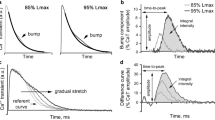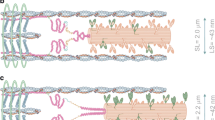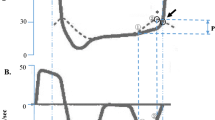Abstract
It is well known that the rate of intracellular calcium ([Ca2+]i) decline is an important factor governing relaxation in unloaded myocardium. However, it remains unclear to what extent, under near physiological conditions, the intracellular calcium transient amplitude and kinetics contribute to the length-dependent increase in force and increase in duration of relaxation. We hypothesize that myofilament properties rather than calcium transient decline primarily determines the duration of relaxation in adult mammalian myocardium. To test this hypothesis, we simultaneously measured force of contraction and calibrated [Ca2+]i transients in isolated, thin rabbit trabeculae at various lengths at 37°C. Time from peak tension to 50% relaxation (RT50(tension)) increases significantly with length (from 49.8 ± 3.4 to 83.8 ± 7.4 ms at an [Ca2+]o of 2.5 mM), whereas time from peak calcium to 50% decline (RT50(calcium)) was not prolonged (from 124.8 ± 5.3 to 107.7 ± 11.4 ms at an [Ca2+]o of 2.5 mM). Analysis of variance revealed that RT50(tension) is significantly correlated with length (P < 0.0001). At optimal length, varying the extracellular calcium concentration increased both developed force and calcium transient amplitude, but RT50(tension) remained unchanged (P = 0.90), whereas intracellular calcium decline actually accelerated (P < 0.05). Thus, an increase in muscle length will result in an increase in both force and duration of relaxation, whereas the latter is not primarily governed by the rate of [Ca2+]i decline.







Similar content being viewed by others
References
Allen DG, Kurihara S (1982) The effects of muscle length on intracellular calcium transients in mammalian cardiac muscle. J Physiol (Lond) 327:79–94
Backx PH, Ter Keurs HE (1993) Fluorescent properties of rat cardiac trabeculae microinjected with fura-2 salt. Am J Physiol Heart Circ Physiol 264:H1098–H1110
Bers DM (2002) Cardiac excitation-contraction coupling. Nature 415:198–205
Bers DM, Berlin JR (1995) Kinetics of [Ca]i decline in cardiac myocytes depend on peak [Ca]i. Am J Physiol 268:C271–C277
Bers DM, Despa S (2006) Cardiac myocytes Ca2+ and Na+ regulation in normal and failing hearts. J Pharmacol Sci 100:315–322
Davis JP, Tikunova SB, Walsh MP, Johnson JD (1999) Characterizing the response of calcium signal transducers to generated calcium transients. Biochemistry 38:4235–4244
de Tombe PP (2003) Cardiac myofilaments: mechanics and regulation. J Biomech 36:721–730
Gaasch WH, Zile MR (2004) Left ventricular diastolic dysfunction and diastolic heart failure. Annu Rev Med 55:373–394
Gao WD, Atar D, Backx PH, Marban E (1995) Relationship between intracellular calcium and contractile force in stunned myocardium. Direct evidence for decreased myofilament Ca2+ responsiveness and altered diastolic function in intact ventricular muscle. Circ Res 76:1036–1048
Gordon AM, Homsher E, Regnier M (2000) Regulation of contraction in striated muscle. Physiol Rev 80:853–924
Grossman W (1990) Diastolic dysfunction and congestive heart failure. Circulation 81:III1–III7
Hinken AC, Solaro RJ (2007) A dominant role of cardiac molecular motors in the intrinsic regulation of ventricular ejection and relaxation. Physiology (Bethesda) 22:73–80
Hiranandani N, Varian KD, Monasky MM, Janssen PM (2006) Frequency-dependent contractile response of isolated cardiac trabeculae under hypo-, normo-, and hyperthermic conditions. J Appl Physiol 100:1727–1732
Hunter WC (2000) Role of myofilaments and calcium handling in left ventricular relaxation. Cardiol Clin 18:443–457
Hussan J, de Tombe PP, Rice JJ (2006) A spatially detailed myofilament model as a basis for large-scale biological simulations. Ibm J Res Develop 50:583–600
Janssen PML, de Tombe PP (1997) Uncontrolled sarcomere shortening increases intracellular Ca2+ transient in rat cardiac trabeculae. Am J Physiol 272:H1892–H1897
Janssen PML, Hunter WC (1995) Force, not sarcomere length, correlates with prolongation of isosarcometric contraction. Am J Physiol Heart Circ Physiol 269:H676–H685
Janssen PML, Stull LB, Marban E (2002) Myofilament properties comprise the rate-limiting step for cardiac relaxation at body temperature in the rat. Am J Physiol Heart Circ Physiol 282:H499–H507
Kranias EG, Solaro RJ (1982) Phosphorylation of troponin I and phospholamban during catecholamine stimulation of rabbit heart. Nature 298:182–184
Layland J, Kentish JC (1999) Positive force- and [Ca2+]i-frequency relationships in rat ventricular trabeculae at physiological frequencies. Am J Physiol Heart Circ Physiol 276:H9–H18
Malmqvist UP, Aronshtam A, Lowey S (2004) Cardiac myosin isoforms from different species have unique enzymatic and mechanical properties. Biochemistry 43:15058–15065
Mulieri LA, Hasenfuss G, Ittleman F, Blanchard EM, Alpert NR (1989) Protection of human left ventricular myocardium from cutting injury with 2,3-butanedione monoxime. Circ Res 65:1441–1449
Niederer SA, Hunter PJ, Smith NP (2006) A quantitative analysis of cardiac myocyte relaxation: a simulation study. Biophysical Journal 90:1697–1722
Pan BS, Solaro RJ (1987) Calcium-binding properties of troponin C in detergent-skinned heart muscle fibers. J Biol Chem 262:7839–7849
Parmley WW, Chuck L (1973) Length-dependent changes in myocardial contractile state. Am J Physiol 224:1195–1199
Poggesi C, Tesi C, Stehle R (2005) Sarcomeric determinants of striated muscle relaxation kinetics. Pflugers Arch 449:505–517
Raman S, Kelley MA, Janssen PM (2006) Effect of muscle dimensions on trabecular contractile performance under physiological conditions. Pflugers Arch 451:625–630
Rice JJ, Jafri MS, Winslow RL (2000) Modeling short-term interval-force relations in cardiac muscle. Am J Physiol Heart Circ Physiol 278:H913–H931
Rodriguez EK, Hunter WC, Royce MJ, Leppo MK, Douglas AS, Weisman HF (1992) A method to reconstruct myocardial sarcomere lengths and orientations at transmural sites in beating canine hearts. Am J Physiol 263:H293–H306
Schneider NS, Shimayoshi T, Amano A, Matsuda T (2006) Mechanism of the Frank-Starling law - A simulation study with a novel cardiac muscle contraction model that includes titin and troponin I. J Mol Cell Cardiol 41:522–536
Stull LB, Leppo M, Marban E, Janssen PML (2002) Physiological determinants of contractile force generation and calcium handling in mouse myocardium. J Mol Cell Cardiol 34:1367–1376
Swartz DR, Zhang D, Yancey KW (1999) Cross bridge-dependent activation of contraction in cardiac myofibrils at low pH. Am J Physiol 276:H1460–H1467
Varian KD, Janssen PM (2007) Frequency-dependent acceleration of relaxation involves decreased myofilament calcium sensitivity. Am J Physiol Heart Circ Physiol 292:H2212–H2219
Varian KD, Raman S, Janssen PM (2006) Measurement of myofilament calcium sensitivity at physiological temperature in intact cardiac trabeculae. Am J Physiol Heart Circ Physiol 290:H2092–H2097
Wannenburg T, Janssen PML, Fan D, de Tombe PP (1997) The Frank-Starling mechanism is not mediated by changes in rate of cross-bridge detachment. Am J Physiol Heart Circ Physiol 273:H2428–H2435
Acknowledgment
This study was supported by National Heart, Lung, and Blood Institute grants R01 746387 and KO2 83957 (PMLJ), an established investigator award of the American Heart Association 0740040 (PMLJ), and a scientist development grant from the American Heart Association 0735079N (JPD).
Author information
Authors and Affiliations
Corresponding author
Rights and permissions
About this article
Cite this article
Monasky, M.M., Varian, K.D., Davis, J.P. et al. Dissociation of force decline from calcium decline by preload in isolated rabbit myocardium. Pflugers Arch - Eur J Physiol 456, 267–276 (2008). https://doi.org/10.1007/s00424-007-0394-0
Received:
Revised:
Accepted:
Published:
Issue Date:
DOI: https://doi.org/10.1007/s00424-007-0394-0




